Display Week is in full swing as this is posted and, unfortunately, I am not there to write a Display Daily straight from the trade show floor or the technical symposium. So, instead, I’ll report on the new products that the SID has seen fit to choose for its 2019 Display Industry Awards.

These awards are in three categories: Displays of the Year, awarded to display products with the most significant technological advances or outstanding features; Display Components of the Year, awarded to novel components that significantly enhanced a display’s performance; and Display Applications of the Year, awarded to applications of displays where the display itself is not necessarily a new device. This year there are three winners in the Display of the Year category and two each in the Display Component of the Year and Display Application of the Year categories.
Display of the Year: Apple’s LTPO OLED Display
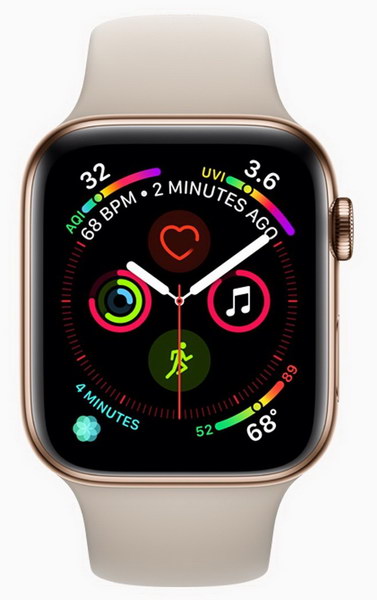 Apple Watch Series 4 with a LTPO Backplane (Credit: Apple)
Apple Watch Series 4 with a LTPO Backplane (Credit: Apple)
Low-Temperature Polycrystalline Oxide, LTPO, is a backplane technology developed by Apple, primarily for use in OLED displays. LTPO combines both LTPS (low temperature polysilicon) TFTs and IGZO (Indium Gallium Zinc Oxide) TFTs on a single backplane. The LTPS TFTs are the display switching elements and the IGZO TFTs are used to drive the OLED material. Apple first introduced the LTPO backplane in 2014. The current Series 4 Apple Watch uses either a 1.78″ (45 mm) diagonal display with 448 x 363 resolution on the 44 mm watch and a 1.57″ (40 mm) display with 394 x 324 on the 40 mm model. Both displays have about 324 pixels per inch. The LTPO backplane is said to reduce power consumption compared to other OLED backplane designs, a very important property for a smart watch.
Display of the Year: The Wall from Samsung Electronics
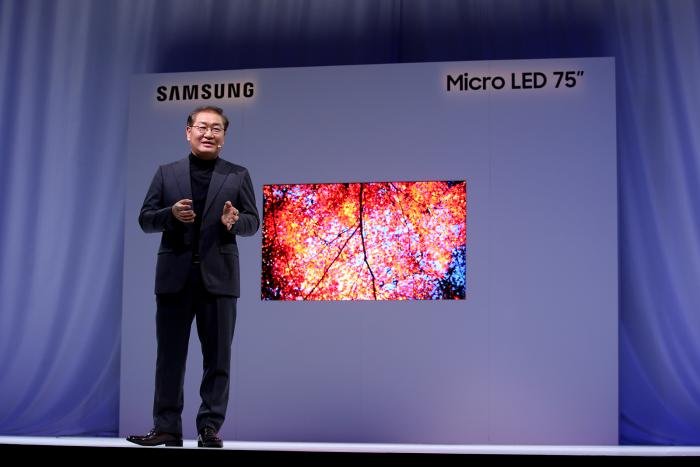 75” microLED display from Samsung shown at CES in January (Credit: Samsung)Samsung Electronics’ Modular MicroLED Display known as The Wall won the second Display of the Year award. This unit has been shown before, including at CES earlier this year. The Wall itself is 219” in diagonal with 8K resolution, implying a 0.63mm pixel pitch which would be invisible except at very close distances. Samsung uses what it calls Black Seal technology, which is applied to each microLED to creates a seamless, uniform canvas with deeper blacks. The Wall uses AI-based upscaling technology and supports HDR10+ with a peak brightness of 2000 cd/m². At CES in January, Samsung also showed a 75”, 4K version of the system which implies a 0.43mm pixel pitch. The Samsung microLED display system was also a 2019 CES Best of Innovation Award winner.
75” microLED display from Samsung shown at CES in January (Credit: Samsung)Samsung Electronics’ Modular MicroLED Display known as The Wall won the second Display of the Year award. This unit has been shown before, including at CES earlier this year. The Wall itself is 219” in diagonal with 8K resolution, implying a 0.63mm pixel pitch which would be invisible except at very close distances. Samsung uses what it calls Black Seal technology, which is applied to each microLED to creates a seamless, uniform canvas with deeper blacks. The Wall uses AI-based upscaling technology and supports HDR10+ with a peak brightness of 2000 cd/m². At CES in January, Samsung also showed a 75”, 4K version of the system which implies a 0.43mm pixel pitch. The Samsung microLED display system was also a 2019 CES Best of Innovation Award winner.
Display of the Year: Sony’s Crystal LED Display System
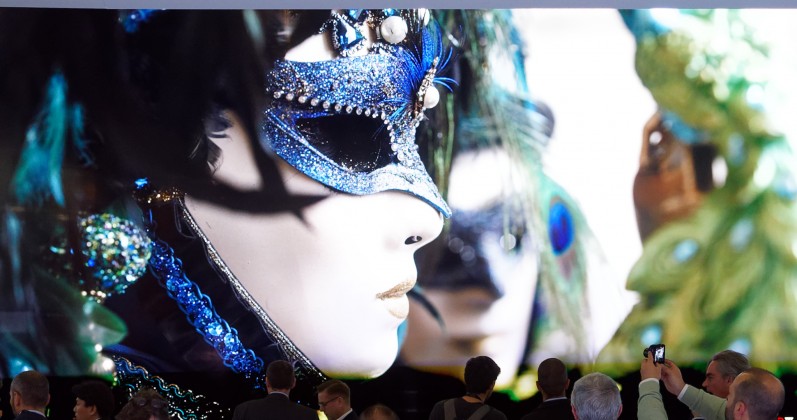 Sony’s CrystalLED display at ISE 2019 (Credit: Bob Raikes)Sony’s Crystal LED display system (CrystalLED formerly known as CLEDIS) is a direct competitor with Samsung’s The Wall and was also awarded a SID Display of the Year award. Personally, I think two awards for similar products is justified because I see microLEDs as the best display technology available in 2019, in terms of image quality. Now, if only the manufacturers could solve the pesky cost problem that makes the technology impractical for any except the very richest end users. The CrystalLED system never fails to look very, very good when I see it. Among all the thousands of displays at ISE this year, it was featured in a Display Daily by Bob Raikes, who said
Sony’s CrystalLED display at ISE 2019 (Credit: Bob Raikes)Sony’s Crystal LED display system (CrystalLED formerly known as CLEDIS) is a direct competitor with Samsung’s The Wall and was also awarded a SID Display of the Year award. Personally, I think two awards for similar products is justified because I see microLEDs as the best display technology available in 2019, in terms of image quality. Now, if only the manufacturers could solve the pesky cost problem that makes the technology impractical for any except the very richest end users. The CrystalLED system never fails to look very, very good when I see it. Among all the thousands of displays at ISE this year, it was featured in a Display Daily by Bob Raikes, who said
“In terms of sheer impact, Sony’s CrystalLED showing some of Sony’s gorgeous 8K content on a display of 9.7 x 5.4 metres … was a stand-out.”
I saw a smaller version of the CrystalLED display at ISE 2018 and was equally impressed. One of the things that makes the system so good is the fact that the microLEDs cover only about 1% of the surface area and the other 99% is a black, light absorbing material. This allows very high contrast, up to 1,000,000:1 and the low reflectivity of the system provides good contrast even on a brightly lit trade show floor.
Display Component of the Year: Dexerials Corp.’s AR Films for Piano Black Design
 Structure of Dexerials AR100-T062V-BD AR film, which is believed to be similar to the award-winning AR100-T0810 film. (Credit: Dexerials)
Structure of Dexerials AR100-T062V-BD AR film, which is believed to be similar to the award-winning AR100-T0810 film. (Credit: Dexerials)
Dexerials’ new AR film, AR100-T0810, was developed by the company specifically at the request of automobile manufacturers for use in the interiors of new cars. “Piano Black” is a slightly lustrous surface finish on a dead-black background and gets its name for the resemblance to the black finish on high-end pianos. In an automotive display application, the black background is provided by the low reflectivity of the display. In addition, the film uses a 75% transmission adhesive layer instead of the more common 99% transmission layer.
While this reduces the display brightness by 25%, it reduces reflected light by about 50%, enhancing contrast in the presence of ambient light. In most automotive displays, the brightness loss can be compensated for by increasing the LED backlight power. The AR100-T0810 film achieves 0.3% reflectivity while maintaining high gloss and minimizing color shift, even at high viewing angles. In automotive applications this off-axis performance is needed because displays are often viewed off-axis by the driver and the passengers in the car. The anti-reflection film has five layers of metal-oxides sputtered on the surface of triacetylcellulose (TAC) substrate. The film is manufactured in a roll-to-roll process under cleanroom conditions to achieve high quality.
Display Component of the Year: SCHOTT’s RealView High-Refractive Index Glass Wafers
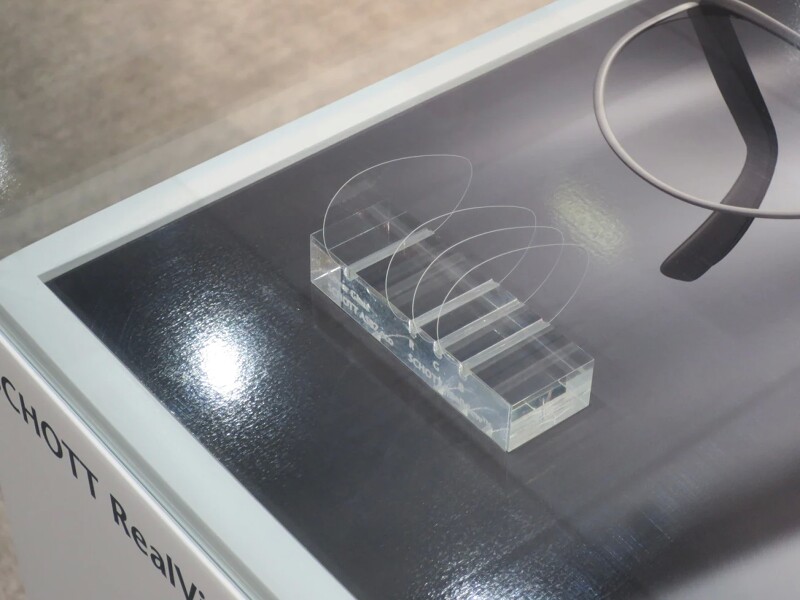 Schott RealView glass wafers on display at SID 2018 (Credit: M. Brennesholtz)
Schott RealView glass wafers on display at SID 2018 (Credit: M. Brennesholtz)
Schott introduced its RealView glass at SID 2018. This glass is intended for use in see-through wave guide plates in near-the-eye (NTE) augmented reality (AR) and mixed reality (MR) HMDs. High index glass is desired in this application because it allows a wider field of view by controlling the total internal reflection angle of the light being channeled by the glass. In addition, the glass has very high surface quality, good thickness control and high internal quality to minimize stray light and veiling glare.
Display Application of the Year: Lenovo’s Yoga Book C930 with Dual Display
 The Lenovo Yoga Book C930 2-in-1 laptop in various configurations (Credit: Lenovo)
The Lenovo Yoga Book C930 2-in-1 laptop in various configurations (Credit: Lenovo)
The Lenovo Yoga Book C930 won a display application award for its use of two relatively conventional displays: a QHD (2560 x 1600) touch screen LCD display as the upper display and a FHD (1920 x 1080) touch-screen E Ink e-paper display with haptic feedback as the lower display. When the system is used as a conventional notebook, a keyboard is shown on the lower display and the touch screen with haptic feedback allows for normal touch typing. AI is built in that is said to learn your typing style and allow your speed to increase the more you use it. The lower screen can also be used for pen input or as a sketch pad in conjunction with the upper display. The upper display may also be turned off, allowing the system to be used as a low-power e-book reader, sketch pad or e-mail reader.
Display Application of the Year: Japan Display Inc.’s Curved LCDs for Automotive Dashboards
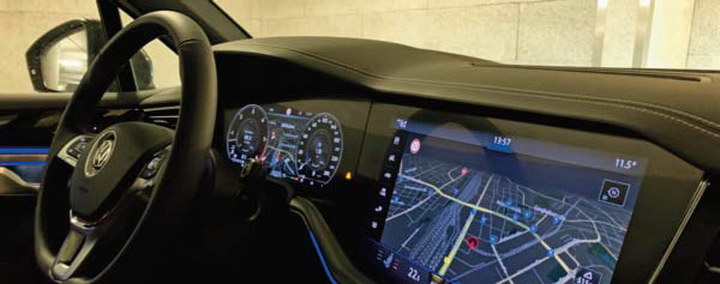 Two of JDI’s curved LCD displays in an automotive dashboard application (Credit: Japan Display Inc.)
Two of JDI’s curved LCD displays in an automotive dashboard application (Credit: Japan Display Inc.)
Japan Display Inc. (JDI) received a display application award for its curved LCD display specifically designed for automotive applications. Two displays of this type, 12.3” and 15.0” were designed in collaboration with Volkswagen in Germany, and were introduced to the consumer market in the Touareg SUV dashboard, which was introduced in May 2018. Both displays have a concave curvature. The 15.0” unit has a 3,000mm radius and 1,920 x 1,020 resolution, LED backlight with 900 cd/m² luminance, and in-cell touch functionality, said to be the world’s first curved display in mass production with in-cell touch functionality. The 12.3” Display has a 1,500mm radius with 1,920 x 720 resolution and an LED backlight with 780 cd/m² luminance.
The honorees were formally recognized during the awards luncheon on Wednesday, May 15, as part of SID’s Display Week in San Jose, May 12-17, 2019. Dr. Wei Chen, Chair of the Display Industry Awards Committee for the SID said:
“The annual Display Industry Awards luncheon is always a much-anticipated highlight of Display Week because it allows us to showcase the high-quality, innovative work that is taking place in the display industry at every level from components to end products. This year’s winners reflect the breadth and depth of recent product development and technology innovation necessary to support the relentless pace of consumer and industrial electronics evolution.”
– Matthew Brennesholtz

